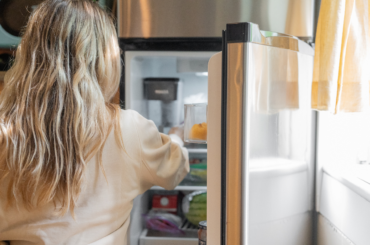There are many reasons kids love sensory play (like the whole slime trend), and it’s not just that you’re letting them get messy, although that can certainly add fun to the equation!
Sensory play doesn’t even have to be messy or slime-adjacent — it’s any type of play that engages the senses. It often involves exploring different textures and materials in an open-ended way.
Here are just some of the awesome developmental benefits of sensory play for kids:
- Keeps kids occupied without screens — hands-on play is more engaging for the mind and body than watching a video
- Gives kids a fun way to practice motor skills at their own pace
- Has a calming effect, and can teach mindfulness and healthy emotional coping skills
- Encourages curiosity, STEM thinking, and exploration of the world around them
- Can promote social interaction and language skills, and allows people of all ages and abilities to participate
Sensory play doesn’t need to be complicated. Simply letting your kids do things like play with play dough, stomp in puddles, or help you with cooking also counts as sensory play. But when you’re looking to set up a unique activity to occupy your kids, here are some easy ways to get started — with materials you’re likely to already have around the house.
And when it’s time to clean up, you can also make that process a part of play time. To ease the transition, tap into your kid’s imagination and say something playful, like, “Now let’s be snow plows and push this ‘snow’ into piles!”
Dry sensory play ideas
Who needs toys? A tray full of dry rice, lentils, beans, pasta, and other dry foods can be so much fun for kids. Non-food items like buttons or packing peanuts can provide the same kind of entertainment! Just offer a few measuring spoons and containers of different sizes, and kids can pour, scoop, mix, and sort to their hearts’ content.
Using dry objects for sensory play can make cleanup seem way easier, so it’s a good introduction for parents or caregivers who aren’t as comfortable with messes.
Wet sensory play ideas
It’s amazing how much time kids can spend just with water and a few containers and sponges — at the sink or kitchen counter, or in the bathtub. Add a few different objects that might float (like plastic caps or corks), and something that will change texture or color in the water (like cardboard).
Dollops of foaming soap, or even whipped cream or frothed milk, can also add tons of fun to water play or a bath! But read your labels carefully before letting a child play with products like shaving cream.
On a hot day, add ice to water play — it’s fun to observe as it melts, plus kids will stay even cooler while playing.
Mushy sensory play ideas
To some kids (and adults!), there is something delightful about getting your hands really…mucky. When it’s warm enough outside, making mud pies is a classic!
One easy way to indulge in this kind of sensory play indoors is to add mashed potato flakes, flour, or corn starch to water, and let kids mix it until it turns into a paste- or dough-like texture. (You can even make your own play dough if you’re feeling ambitious!)
You can also let kids help mash potatoes or bananas, or make peanut butter and oatmeal balls with their hands. Adding ingredients like shredded coconut or raisins changes the texture and engages the senses further.
Crunchy sensory play ideas
Crunching and crushing things can be so satisfying for multiple senses. Often nature provides these opportunities — think stomping in dry leaves or cracking thin sheets of ice on cold days.
To get that crunch in other ways, you can have kids crush up cookies, crackers, cereal, or candy canes in a ziplock bag or using a potato masher or toy hammer. Then use it as a topping for yogurt or pudding. If kids are old enough, teaching them to use a nutcracker could give them a similar sense of satisfaction.
Musical sensory play ideas
There are so many ways to explore musical sounds and vibrations using just household materials. These ideas are high in educational value and low on mess!
For percussion, let kids drum on various containers and overturned bowls, and compare the different sounds. Or fill a bottle with tiny items (see dry sensory play ideas above), cover, and shake it up.
For string instruments, elastic bands stretched over open containers will do the trick. And for wind instruments, filling bottles with different amounts of water and blowing over the tops is a fascinating activity for all ages.







